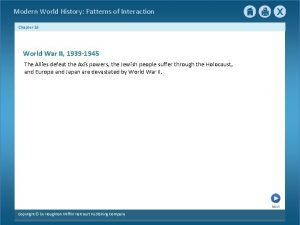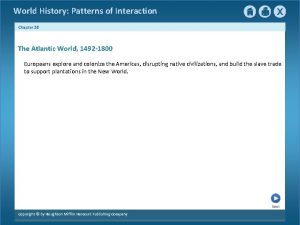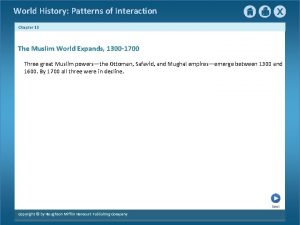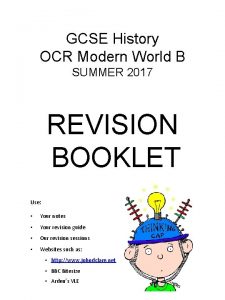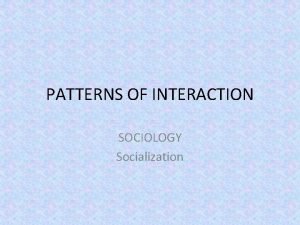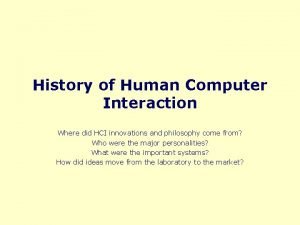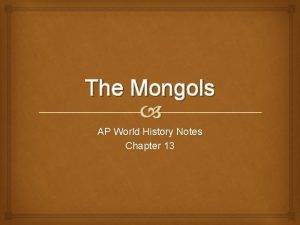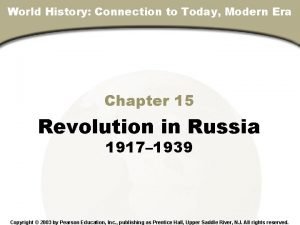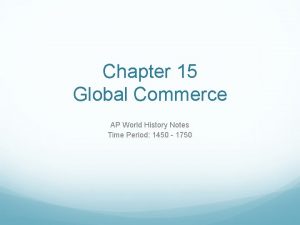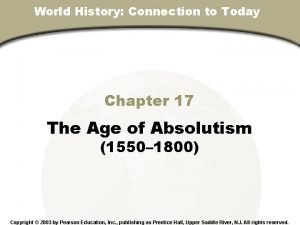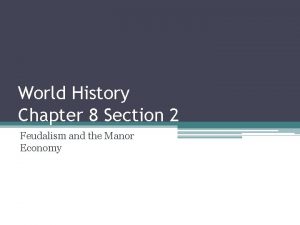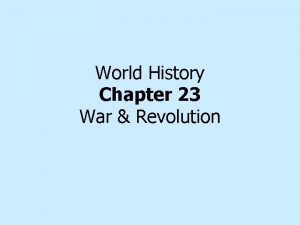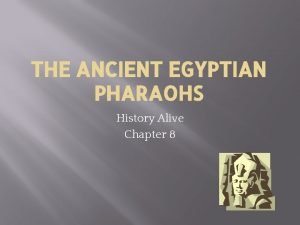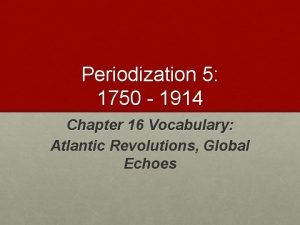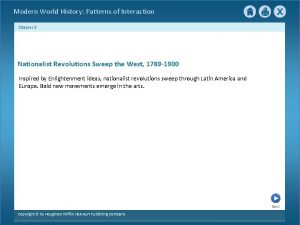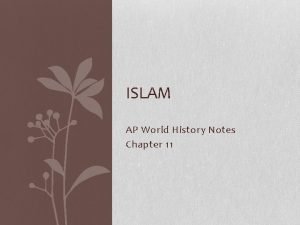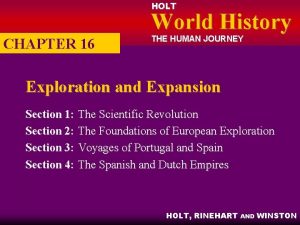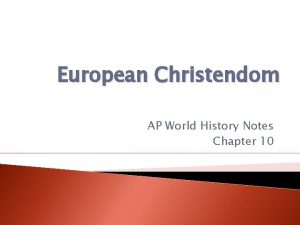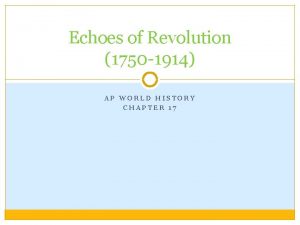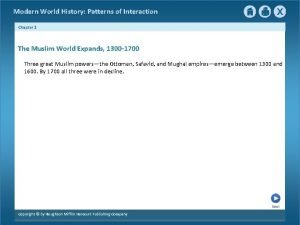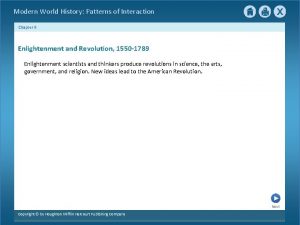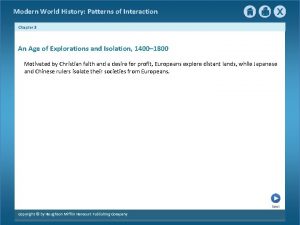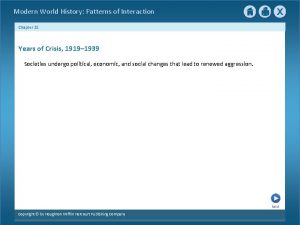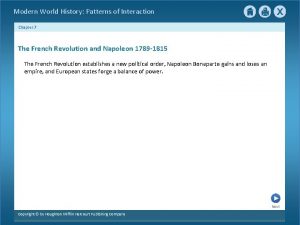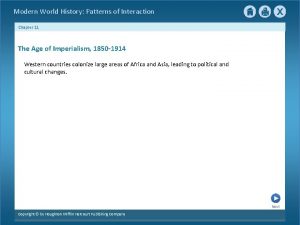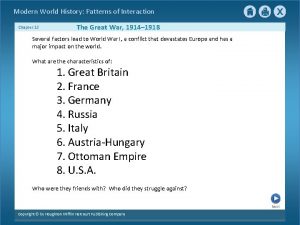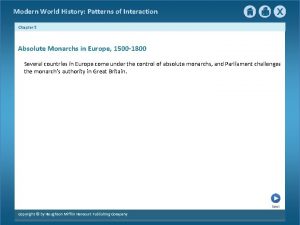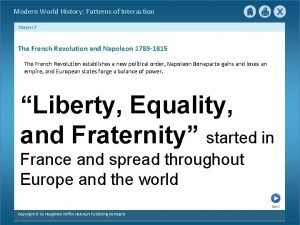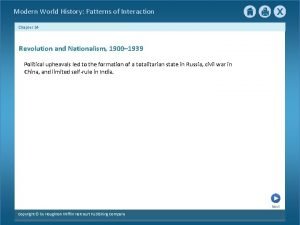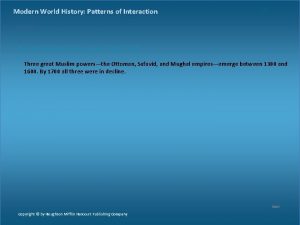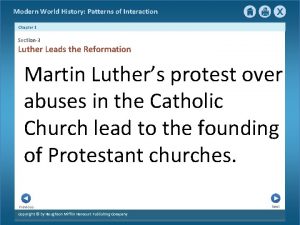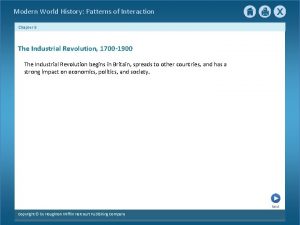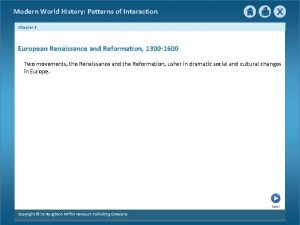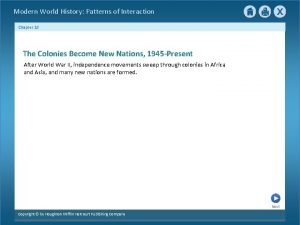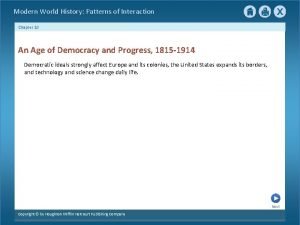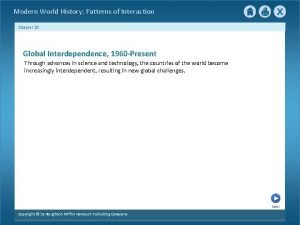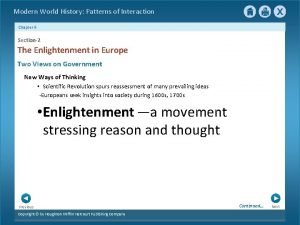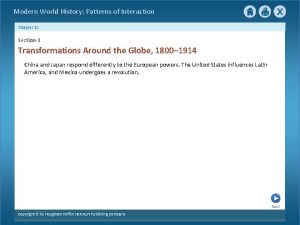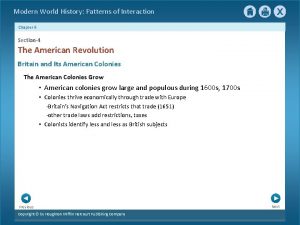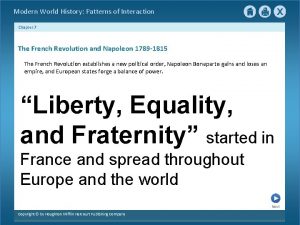Modern World History Patterns of Interaction Chapter 8































- Slides: 31

Modern World History: Patterns of Interaction Chapter 8 Nationalist Revolutions Sweep the West, 1789 -1900 Inspired by Enlightenment ideas, nationalist revolutions sweep through Latin America and Europe. Bold new movements emerge in the arts. Next Copyright © by Houghton Mifflin Harcourt Publishing Company

Modern World History: Patterns of Interaction Chapter 8 Nationalist Revolutions Sweep the West, 1789 -1900 SECTION 1 Latin American Peoples Win Independence SECTION 2 Europe Faces Revolutions SECTION 3 CASE STUDY: Nationalism SECTION 4 Revolutions in the Arts Previous Copyright © by Houghton Mifflin Harcourt Publishing Company Next

Modern World History: Patterns of Interaction Chapter 8 Section-1 Latin American Peoples Win Independence Spurred by discontent and Enlightenment ideas, peoples in Latin America fight colonial rule. Previous Copyright © by Houghton Mifflin Harcourt Publishing Company Next

Modern World History: Patterns of Interaction Chapter 8 Section-1 Latin American Peoples Win Independence Colonial Society Divided A Race and Class System • Latin America has social classes that determine jobs and authority: • Peninsulares —born in Spain, they head colonial government, society • Creoles—American-born Spaniards who can become army officers • Mestizos have both European and Indian ancestry • Mulattos—Have both European and African ancestry • Slaves, Indians are at the bottom of society Previous Copyright © by Houghton Mifflin Harcourt Publishing Company Next

Modern World History: Patterns of Interaction Chapter 8 Revolutions in the Americas Revolution in Haiti • Haiti is first Latin American territory to gain freedom • Toussaint L’Ouverture leads slave revolt against French (1791) • Toussaint eventually dies in French prison in 1803 Haiti’s • • • Independence Jean-Jacques Dessalines declares Saint Domingue a country in 1804 Saint Domingue becomes first black colony to win independence Renamed Haiti, means “mountainous land” in the Arawak language Previous Copyright © by Houghton Mifflin Harcourt Publishing Company Next

Modern World History: Patterns of Interaction Chapter 8 Creoles Lead Independence The Spread of Enlightenment Ideas • Enlightenment ideas inspire Latin American revolutionaries Creole Leaders • Simón Bolívar—wealthy Creole leads Venezuela in revolution • José de San Martín—leader of Argentinean revolutionary forces Previous Copyright © by Houghton Mifflin Harcourt Publishing Company Continued… Next

Modern World History: Patterns of Interaction Chapter 8 Creoles Lead Independence {continued} Bolívar’s Route to Victory • Venezuela declares independence in 1811; Bolívar wins war by 1821 San Martín Leads Southern Liberation Forces • Argentina independent in 1816; San Martín helps free Chile • Bolívar’s and San Martín’s armies drive Spanish out of Peru in 1824 Previous Copyright © by Houghton Mifflin Harcourt Publishing Company Next

Modern World History: Patterns of Interaction Chapter 8 Mexico Ends Spanish Rule A Cry for Freedom • Padre Miguel Hidalgo—priest who launches Mexican revolt (1810) • 80, 000 Indian and mestizo followers march on Mexico City • José María Morelos—leads revolt after Hidalgo’s defeat, but loses Mexico’s Independence • Mexican creoles react; Iturbide declares Mexico independent (1821) • In 1823, Central America breaks away from Mexico Previous Copyright © by Houghton Mifflin Harcourt Publishing Company Next

Modern World History: Patterns of Interaction Chapter 8 Brazil’s Royal Liberator A Bloodless Revolution • Napoleon invades Portugal; royal family moves to Brazil (1807) • Portuguese court returns to Portugal after Napoleon’s defeat (1815) • Portuguese prince Dom Pedro stays behind in Brazil -accepts Brazilians’ request to rule their new country -officially declares Brazil’s independence (September 1822) • By 1830, nearly all Latin American regions win independence Previous Copyright © by Houghton Mifflin Harcourt Publishing Company Next

Modern World History: Patterns of Interaction Chapter 8 Section-2 Europe Faces Revolutions Liberal and nationalist uprisings challenge the old conservative order of Europe. Previous Copyright © by Houghton Mifflin Harcourt Publishing Company Next

Modern World History: Patterns of Interaction Chapter 8 Section-2 Europe Faces Revolutions Crash of Philosophies Three • • Philosophies In early 1800 s, three schools of political thought conflict in Europe Conservative —landowners, nobles want traditional monarchies Liberal—wealthy merchants, business owners want limited democracy Radical—believe in liberty, equality; want everyone to have a vote Previous Copyright © by Houghton Mifflin Harcourt Publishing Company Next

Modern World History: Patterns of Interaction Chapter 8 Nationalism Develops Nationalism and Nation-States • Nationalism—loyalty to nation of people with common culture, history • Nation-state —nation with its own independent government • In 1815 Europe, only France, England, and Spain are nation-states • Liberals and radicals support nationalism; conservatives do not Previous Copyright © by Houghton Mifflin Harcourt Publishing Company Next

Modern World History: Patterns of Interaction Chapter 8 Nationalists Challenge Conservative Power Greeks Gain Independence • Balkans—region of Europe controlled by Ottomans in early 1800 s • Greece gets European help to gain independence from Turks 1830 s Uprisings Crushed • Belgian, Italian, Polish liberals and nationalists launch revolts • By the mid-1830 s, conservatives are back in control 1848 Revolutions Fail to Unite • Ethnic uprisings in Europe, especially in the Austrian empire • Liberals hold power for short time, lose to conservatives by 1849 Previous Copyright © by Houghton Mifflin Harcourt Publishing Company Next

Modern World History: Patterns of Interaction Chapter 8 Radicals Change France Conservative Defeat • In 1830, France’s Charles X fails to restore absolute monarchy The Third Republic • In 1848, Paris mob overthrows monarchy, sets up republic • Radicals split by infighting; moderates control new government • 1848 constitution calls for elected president and parliament France Accepts a Strong Ruler • Louis-Napoleon —Napoleon’s nephew—elected president • Later takes the title of emperor, promotes industrialization Previous Copyright © by Houghton Mifflin Harcourt Publishing Company Next

Modern World History: Patterns of Interaction Chapter 8 Reform in Russia Serfdom in Russia • Czars fail to free serfs because they fear losing landowners’ support Defeat Brings Change • Russia’s lack of industrialization leads to military defeat in Crimean War • Alexander II—czar who determines to make social and economic changes Reform and Reaction • In 1861, czar frees serfs, but debt keeps them on the same land • Reform halts when Alexander is assassinated by terrorists in 1881 • Driven by nationalism, Alexander III encourages industrialization Previous Copyright © by Houghton Mifflin Harcourt Publishing Company Next

Modern World History: Patterns of Interaction Chapter 8 Section-3 Nationalism CASE STUDY: Italy and Germany Nationalism contributes to the formation of two new nations and a new political order in Europe. Previous Copyright © by Houghton Mifflin Harcourt Publishing Company Next

Modern World History: Patterns of Interaction Chapter 8 Nationalism: A Force for Unity or Disunity CASE STUDY: Italy and Germany Two Views of Nationalism • Nationalists use their common bonds to build nation-states • Rulers eventually use nationalism to unify their subjects -Three different types of nationalist movements: -unification merges culturally similar lands -separation splits off culturally distinct groups -state-building binds separate cultures into one Previous Copyright © by Houghton Mifflin Harcourt Publishing Company Next

Modern World History: Patterns of Interaction Chapter 8 Nationalism Shakes Aging Empires The Breakup of the Austrian Empire • Austria includes people from many ethnic groups • 1866 defeat forces emperor to split empire into Austria and Hungary -still ruled by emperor The Russian Empire Crumbles • After 370 years, Russian czars begin losing control over empire • Russification —forcing other peoples to adopt Russian culture -policy further disunites Russia, strengthens ethnic nationalism Previous Copyright © by Houghton Mifflin Harcourt Publishing Company Continued… Next

Modern World History: Patterns of Interaction Chapter 8 Nationalism Shakes Aging Empires {continued} The Ottoman Empire Weakens • Internal tensions among ethnic groups weakens empire • Rulers grant citizenship to all groups, outraging Turks Previous Copyright © by Houghton Mifflin Harcourt Publishing Company Next

Modern World History: Patterns of Interaction Chapter 8 Cavour Unites Italy Cavour Leads Italian Unification • Camillo di Cavour—prime minister of kingdom of Sardinia in 1852 • Gets French help to win control of Austrian-controlled Italian land Garibaldi Brings Unity • Giuseppe Garibaldi—leads nationalists who conquer southern Italy • Cavour convinces Garibaldi to unite southern Italy and Sardinia • Garibaldi steps aside, allowing king of Sardinia to rule • Control of Venetia, Papal States finally unites Italy Previous Copyright © by Houghton Mifflin Harcourt Publishing Company Next

Modern World History: Patterns of Interaction Chapter 8 Bismarck Unites Germany Prussia Leads German Unification • Prussia has advantages that help it unify Germany: -mainly German population -powerful army -creation of liberal constitution Previous Copyright © by Houghton Mifflin Harcourt Publishing Company Continued… Next

Modern World History: Patterns of Interaction Chapter 8 Bismarck Unites Germany {continued} Bismarck Takes Control • Junkers—conservative wealthy landowners—support Prussian Wilhelm I • Junker realpolitik master Otto von Bismarck becomes prime minister • Realpolitik—power politics without room for idealism • Bismarck defies Prussian parliament Prussia Expands • Prussia and Austria fight Denmark, gain two provinces • Quick victory makes other German nations respect Prussia Previous Copyright © by Houghton Mifflin Harcourt Publishing Company Continued… Next

Modern World History: Patterns of Interaction Chapter 8 Bismarck Unites Germany {continued} Seven Weeks’ War • Bismarck creates border dispute with Austria to provoke war • Prussia seizes Austrian territory, northern Germany • Eastern and western parts of Prussian kingdom joined for first time The Franco-Prussian War • Bismarck provokes war with France to unite all Germans • Wilhelm is crowned kaiser—emperor of a united Germany—at Versailles • Bismarck creates a Germany united under Prussian dominance Previous Copyright © by Houghton Mifflin Harcourt Publishing Company Next

Modern World History: Patterns of Interaction Chapter 8 A Shift in Power Balance Is Lost • In 1815 the Congress of Vienna established five powers in Europe: - Austria, Prussia, Britain, France, and Russia • By 1871, Britain and Prussia (now Germany) have gained much power • Austria and Russia are weaker militarily and economically Previous Copyright © by Houghton Mifflin Harcourt Publishing Company Next

Modern World History: Patterns of Interaction Chapter 8 Section-4 Revolutions in the Artistic and intellectual movements both reflect and fuel changes in Europe during the 1800 s. Previous Copyright © by Houghton Mifflin Harcourt Publishing Company Next

Modern World History: Patterns of Interaction Chapter 8 Section-4 Revolutions in the Arts The Romantic Movement The Ideas of Romanticism • Romanticism—interest in nature; preferring emotion, individuality • Romanticism linked to folk traditions and nationalism Romanticism in Literature • Poetry, music, and painting are the arts best suited to romanticism • Many British romantic poets believe nature is the source of beauty • Germany’s Johann Wolfgang von Goethe is a great early romanticist • A leading French romanticist writer is Victor Hugo Previous Copyright © by Houghton Mifflin Harcourt Publishing Company Continued… Next

Modern World History: Patterns of Interaction Chapter 8 The Romantic Movement {continued} The Gothic Novel • Gothic horror novels taking place in medieval castles become popular • One of the earliest and most successful is Frankenstein Composers Emphasize Emotion • Composers abandon Enlightenment style of music • Ludwig van Beethoven leads the way from Enlightenment to romanticism • Some composers draw on literature or cultural themes Previous Copyright © by Houghton Mifflin Harcourt Publishing Company Next

Modern World History: Patterns of Interaction Chapter 8 The Shift to Realism in the Arts Realism • Realism—art style attempting to depict life accurately • Paintings and novels in this style show the working class Photographers Capture Reality • Daguerreotypes, earliest photographs, are surprisingly real • William Talbot invents negative, allows copies of a photograph Writers Study Society • Charles Dickens and Honoré de Balzac write about society, class • Some realist literature sparks reforms in working conditions Previous Copyright © by Houghton Mifflin Harcourt Publishing Company Next

Modern World History: Patterns of Interaction Chapter 8 Impressionists React Against Realism A New Movement • Impressionism —art style that tries to capture precise points in time Life in the Moment • Impressionists like Claude Monet portray life of rising middle class • Edgar Degas and Pierre-Auguste Renoir also leading impressionists • Impressionist composers use music to create mental pictures Previous Copyright © by Houghton Mifflin Harcourt Publishing Company Next

Modern World History: Patterns of Interaction Chapter 8 This is the end of the chapter presentation of lecture notes. Click the HOME or EXIT button. Previous Copyright © by Houghton Mifflin Harcourt Publishing Company Next

Modern World History: Patterns of Interaction Chapter 8 Print Slide Show 1. On the File menu, select Print 2. In the pop-up menu, select Microsoft Power. Point If the dialog box does not include this pop-up, continue to step 4 3. In the Print what box, choose the presentation format you want to print: slides, notes, handouts, or outline 4. Click the Print button to print the Power. Point presentation Previous Copyright © by Houghton Mifflin Harcourt Publishing Company
 World history patterns of interaction
World history patterns of interaction Chapter 20 section 2 european nations settle north america
Chapter 20 section 2 european nations settle north america The golden age chapter 18
The golden age chapter 18 World history patterns of interaction
World history patterns of interaction Ap world history chapter 25 africa and the atlantic world
Ap world history chapter 25 africa and the atlantic world How useful is this source
How useful is this source Social integration and influence in group dynamics
Social integration and influence in group dynamics Mean girls sociology
Mean girls sociology Free floating interaction pattern
Free floating interaction pattern Countries michael jackson visited
Countries michael jackson visited Contemporary dating patterns are formal patterns
Contemporary dating patterns are formal patterns Closed patterns and max-patterns
Closed patterns and max-patterns Interaction framework in hci
Interaction framework in hci Chapter 17 section 3 luther leads the reformation
Chapter 17 section 3 luther leads the reformation Chapter 32 assessment world history
Chapter 32 assessment world history Chapter 30 section 2 world history
Chapter 30 section 2 world history Chapter 15 section 1 world history
Chapter 15 section 1 world history Chapter 13 ap world history
Chapter 13 ap world history Chapter 15 section 3 world history
Chapter 15 section 3 world history Chapter 15 world history
Chapter 15 world history Chapter 15 notes ap world history
Chapter 15 notes ap world history Chapter 17 assessment world history
Chapter 17 assessment world history Chapter 8 section 2 world history
Chapter 8 section 2 world history Chapter 23 section 3 world history
Chapter 23 section 3 world history History alive chapter 8
History alive chapter 8 Ap world chapter 16 vocab
Ap world chapter 16 vocab Chapter 8 section 1 world history
Chapter 8 section 1 world history Chapter 11 ap world history notes
Chapter 11 ap world history notes Chapter 16 section 1 world history
Chapter 16 section 1 world history History alive chapter 14
History alive chapter 14 Chapter 10 the worlds of christendom notes
Chapter 10 the worlds of christendom notes Ap world history chapter 17 multiple choice questions
Ap world history chapter 17 multiple choice questions
